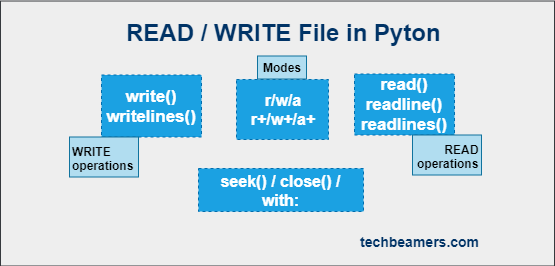

ModuleĪll common operations that are required to work with files are readily available in the builtins module. First, let us start with the modules that we need to use those functions.
#READWRITE FILE HOW TO#
In this article, we will learn about all those functions and how to use them. These functions allow us to work with files efficiently. In python, there are multiple functions to read data from a file and write data to a file. Furthermore, we showed you how to read and write data into both text files and binary files.Python offers some excellent ways of using files.

In this article, we showed you how to use various file operations with the C++ programming language by working through several examples. emp_id << endl įiles are mainly used to store the data, and they play an important role in real-world programming. read ( ( char * ) &empObj_R, sizeof (Employee ) ) Ĭout << "Error occured during reading the binary file!" << endl Ĭout << "Details of the Employee : " << endl Ĭout << "Employee ID : " << empObj_R. open ( "Employee.dat", ios :: in | ios :: binary ) īinInFile_Handler. write ( ( char * ) &empObj_W, sizeof (Employee ) ) Ĭout << "Error occured during writing the binary file!" << endl īinInFile_Handler. open ( "Employee.dat", ios :: out | ios :: binary ) īinOutFile_Handler. Then, we will read the binary file and print the output to the monitor.īinOutFile_Handler. To simplify this example, we have declared the Employee class with a public variable emp_id. In this example, we are going to declare a class and then write the object to a binary file. Now, we will compile and execute the program.Įxample 5: Read and Write to a Binary File While ( getline (myFile_Handler, myLine ) ) open ( "File_1.txt", ios :: in | ios :: out ) Then, we read the data from the file and print it to the monitor. In this example, we first write some content to the file. To both read and write to a file, we have to get an fstream object and open the file in “ios::in” and “ios::out” mode. In C++, we can also read and write to a file at the same time. So far, we have showed you how to open, read, write, and close a file. Therefore, we have successfully read the file and printed the content of the file to the monitor. Once we compile and execute the program, it is clear that the output matches the content of the file. Now, we will print the content of File_1.txt using the following command: cat File_1.txt. While (getline (myFile_Handler, myLine ) ) We can then use the open() function to create an empty file and the close() function to close the file. We have declared a myFile_Handler as an object of ofstream inside the main function. We have included the fstream header file at line number-1 so that we can access ofstream class. Then, to read or write to a file, we have to open the file. To open and close a file, we need an object of ofstream.

As you can see in the below program, we have included the library required for file operations. In this example program, we will demonstrate how to open/create a file and how to close the file in C++. Example 5: Read and Write to a Binary File.Now that you understand the basics of streams, we will discuss the following examples to help you to better understand file operations in C++: The “iostram.h” file contains all the required standard input/output stream classes in the C++ programming language. In addition, “ifstream,” which stands for “input file stream,” is used to read a stream of data from a file, and “ofstream,” which stands for “output file stream,” is used to write a stream of data to a file. The “cin” and “cout” objects are used to read the data from the keyboard and to display the output on the monitor, respectively. Here is the stream class hierarchy of the C++ programming language: We can use built-in classes to access an input/output stream, i.e., “ios”. In C++, we use a stream to send or to receive data to or from an external source. A file can be considered as both an input and output source. An input stream is used to read the data from an external input device such as a keyboard, while an output stream is used to write data to the external output device such as a monitor. There are two types of streams: input streams and output streams. What is a Stream?Ī stream is simply a flow of data or characters. To understand C++ file operations like read and write, we must first understand the concept of a stream in C++. In this article, we are going to show you how to read and write to a file in the C++ programming language by using several examples.


 0 kommentar(er)
0 kommentar(er)
